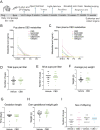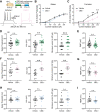Fetal cannabidiol (CBD) exposure alters thermal pain sensitivity, problem-solving, and prefrontal cortex excitability
- PMID: 37433966
- PMCID: PMC10618089
- DOI: 10.1038/s41380-023-02130-y
Fetal cannabidiol (CBD) exposure alters thermal pain sensitivity, problem-solving, and prefrontal cortex excitability
Abstract
Thousands of people suffer from nausea with pregnancy each year. Nausea can be alleviated with cannabidiol (CBD), a primary component of cannabis that is widely available. However, it is unknown how fetal CBD exposure affects embryonic development and postnatal outcomes. CBD binds and activates receptors that are expressed in the fetal brain and are important for brain development, including serotonin receptors (5HT1A), voltage-gated potassium (Kv)7 receptors, and the transient potential vanilloid 1 receptor (TRPV1). Excessive activation of each of these receptors can disrupt neurodevelopment. Here, we test the hypothesis that fetal CBD exposure in mice alters offspring neurodevelopment and postnatal behavior. We administered 50 mg/kg CBD in sunflower oil or sunflower oil alone to pregnant mice from embryonic day 5 through birth. We show that fetal CBD exposure sensitizes adult male offspring to thermal pain through TRPV1. We show that fetal CBD exposure decreases problem-solving behaviors in female CBD-exposed offspring. We demonstrate that fetal CBD exposure increases the minimum current required to elicit action potentials and decreases the number of action potentials in female offspring layer 2/3 prefrontal cortex (PFC) pyramidal neurons. Fetal CBD exposure reduces the amplitude of glutamate uncaging-evoked excitatory post-synaptic currents, consistent with CBD-exposed female problem-solving behavior deficits. Combined, these data show that fetal CBD exposure disrupts neurodevelopment and postnatal behavior in a sex specific manner.
© 2023. The Author(s).
Conflict of interest statement
The authors declare no competing interests.
Figures






References
MeSH terms
Substances
Grants and funding
LinkOut - more resources
Full Text Sources
Miscellaneous

